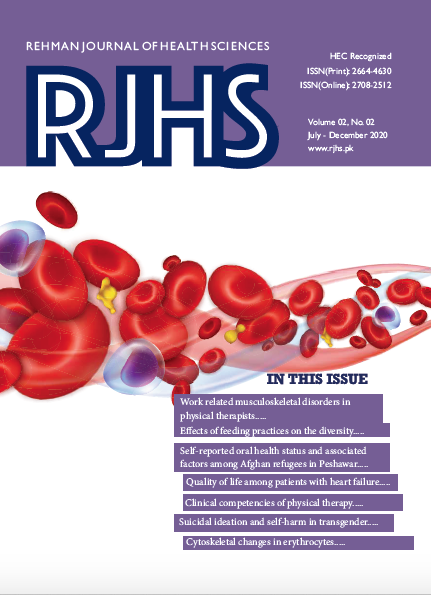Cytoskeletal changes in Erythrocytes during storage in banked blood
DOI:
https://doi.org/10.52442/rjhs.v2i2.74Keywords:
Erythrocytes storage, Fluorescence microscope, Mechanical fragility index, Transfusion safety, Blood storage, Reticulocyte count, Ankyrin1 protein, CytoskeletonAbstract
Introduction: Erythrocytes have flexible, non-nucleated bi-concave shape with lipid bilayer cytoskeleton. Any alterations of erythrocyte shape make it susceptible to hemolysis. Blood for transfusion purpose is routinely stored in Citrate Phosphate Dextrose Adenine (CPDA-1) containing blood bags. During storage, blood undergoes an array of different morphological changes termed as “storage lesions” which makes it more fragile. This study was aimed to determine the structural and functional modifications in erythrocytes in CPDA-1 blood stored in local blood bank of KPK.
Material & Methods: Blood from twenty healthy volunteer donors was taken and kept in CPDA-1 containing blood bags at Institute of Basic Medical Sciences (IBMS), Khyber Medical University (KMU). Hb-levels and Erythrocyte, Reticulocyte counts, Mechanical Fragility Index (MFI) and immunofluorescence staining for ankiyrin1 protein were performed on fresh blood samples. Samples for reticulocyte count was taken for 5 consecutive days while for the remaining parameters, blood was taken at 5 days interval till day 20th. The light and fluorescence micrographs were obtained accordingly and osmotic fragility tests were performed.
Results: A significant mean reduction in erythrocyte counts and Hb-level was observed from day 0 to 20 (p=0.001), while MFI increased from day 0 to day 20 (12.88%±7.58 p=0.001). Reticulocyte count also decreased from day 0 up to day 5 (p=0.001). A weak association was observed between changes in MFI and erythrocyte morphology from day 0 to 20 (r=0.349), while the intensity and pattern of ankyrin1 protein expression appeared to change from day 10.
Conclusion: Blood stored for a week has same properties as fresh blood, however, important structural alterations start to appear after the first week of storage and worsen with time. Therefore, to gain better transfusion results, blood stored for up to one week can safely be transfused.







